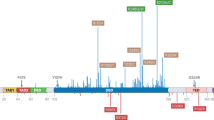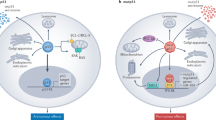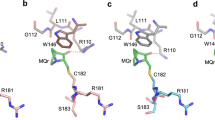Abstract
The p53 tumor suppressor pathway blocks tumor development by triggering apoptosis or cellular senescence in response to oncogenic stress. A large fraction of human tumors carry p53 mutations that disrupt DNA binding of p53 and transcriptional regulation of target genes. Reconstitution of wild-type p53 in vivo triggers rapid elimination of tumors. Therefore, pharmacological reactivation of mutant p53 is a promising strategy for novel cancer therapy. Several approaches for identification of small molecules that target mutant p53 have been applied, including rational design and screening of chemical libraries. The compound PhiKan083 binds with high affinity to a crevice created by the Y220C mutation in p53 and stabilizes the mutant protein. The compound PRIMA-1 (p53 reactivation and induction of massive apoptosis) restores wild-type conformation to mutant p53 by binding to the core and induces apoptosis in human tumor cells. The PRIMA-1 analog APR-246 is currently tested in a clinical trial. Successful development of mutant p53-reactivating anticancer drugs should have a major impact on the treatment of cancer.
This is a preview of subscription content, access via your institution
Access options
Subscribe to this journal
Receive 50 print issues and online access
$259.00 per year
only $5.18 per issue
Buy this article
- Purchase on Springer Link
- Instant access to full article PDF
Prices may be subject to local taxes which are calculated during checkout




Similar content being viewed by others
References
Bartek J, Bartkova J, Lukas J . (2007). DNA damage signalling guards against activated oncogenes and tumor progression. Oncogene 26: 7773–7779.
Bartkova J, Horejsi Z, Koed K, Krämer A, Tort F, Zieger K et al. (2005). DNA damage response as a candidate anti-cancer barrier in early human tumorigenesis. Nature 434: 864–870.
Boeckler FM, Joerger AC, Jaggi G, Rutherford TJ, Veprintsev DB, Fersht AR . (2008). Targeted rescue of a destabilized mutant of p53 by an in silico screened drug. Proc Natl Acad Sci USA 105: 10360–10365.
Brown CJ, Lain S, Verma CS, Fersht AR, Lane DP . (2009). Awakening guardian angels: drugging the p53 pathway. Nat Rev Cancer 9: 862–873.
Bykov VJN, Issaeva N, Shilov A, Hultcrantz M, Pugacheva E, Chumakov P et al. (2002). Restoration of the tumor suppressor function to mutant p53 by a low-molecular-weight compound. Nat Med 8: 282–288.
Bykov VJN, Issaeva N, Zache N, Shilov A, Hultcrantz M, Bergman J et al. (2005a). Restoration of tumor suppressor function to mutant p53 in human tumor cells by a maleimide analog. J Biol Chem 280: 30384–30391.
Bykov VJN, Lambert JMR, Hainaut P, Wiman KG . (2009). Mutant p53 rescue and modulation of p53 redox state. Cell Cycle 8: 2509–2517.
Bykov VJN, Zache N, Stridh H, Westman J, Bergman J, Selivanova G et al. (2005b). PRIMA-1MET synergizes with cisplatin to induce tumor cell apoptosis. Oncogene 24: 3484–3491.
Chipuk JE, Maurer U, Green DR, Schuler M . (2003). Pharmacologic activation of p53 elicits Bax-dependent apoptosis in the absence of transcription. Cancer Cell 4: 371–381.
Cho Y, Gorina S, Jeffrey PD, Pavletich NP . (1994). Crystal structure of a p53 tumor suppressor-DNA complex: understanding tumorigenic mutations. Science 265: 346–355.
Donehower LA, Lozano G . (2009). 20 years studying p53 functions in genetically engineered mice. Nat Rev Cancer 9: 831–841.
Foster BA, Coffey HA, Morin MJ, Rastinejad F . (1999). Pharmacological rescue of mutant p53 conformation and function. Science 286: 2507–2510.
Gaiddon C, Lokshin M, Ahn J, Zhang T, Prives C . (2001). A subset of tumor-derived mutant forms of p53 down-regulate p63 and p73 through a direct interaction with the p53 core domain. Mol Cell Biol 21: 1874–1887.
Green DR, Kroemer G . (2009). Cytoplasmic functions of the tumour suppressor p53. Nature 458: 1127–1130.
Gorgoulis VG, Vassiliou LVF, Karakaidos P, Zacharators P, Kotsinas A, Liloglou T et al. (2005). Activation of the DNA damage checkpoint and genomic instability in human precancerous lesions. Nature 434: 907–913.
Hainaut P, Wiman KG (eds). (2005). 25 Years of p53 Research. Springer: Dordrecht. ISBN 1-4020-2920-9.
Huang C, Zhang XM, Tavaluc RT, Hart LS, Dicker DT, Wang W et al. (2009). The combination of 5-fluorouracil plus p53 pathway restoration is associated with depletion of p53-deficient or mutant p53-expressing putative colon cancer stem cells. Cancer Biol Ther 8: 2186–2193.
Issaeva N, Bozko P, Enge M, Protopopova M, Verhoef LG, Masucci M et al. (2004). Small molecule RITA binds to p53, blocks p53-HDM-2 interaction and activates p53 function in tumors. Nat Med 10: 1321–1328.
Joerger AC, Ang HC, Fersht AR . (2006). Structural basis for understanding oncogenic p53 mutations and designing rescue drugs. Proc Natl Acad Sci USA 103: 15056–15061.
Joerger AC, Fersht AR . (2008). Structural biology of the tumor suppressor p53. Annu Rev Biochem 77: 557–582.
Kudo N, Matsumori N, Taoka H, Fujiwara D, Schreiner EP, Wolff B et al. (1999). Leptomycin B inactivates CRM1/exportin 1 by covalent modification at a cysteine residue in the central conserved region. Proc Natl Acad Sci USA 96: 9112–9117.
Kwak EL, Sordella R, Bell DW, Godin-Heymann N, Okimoto RA, Brannigan BW et al. (2005). Irreversible inhibitors of the EGF receptor may circumvent acquired resistance to gefitinib. Proc Natl Acad Sci USA 102: 7665–7670.
Lain S, Hollick JJ, Campbell J, Staples OD, Higgins M, Aoubala M et al. (2008). Discovery, in vivo activity, and mechanism of action of a small-molecule p53 activator. Cancer Cell 13: 454–463.
Lambert JMR, Gorzov P, Veprintsev DB, Söderqvist M, Segerbäck D, Bergman J et al. (2009). PRIMA-1 reactivates mutant p53 by covalent binding to the core domain. Cancer Cell 15: 376–388.
Lambert JMR, Moshfegh A, Hainaut P, Wiman KG, Bykov VJN . (2010). Mutant p53 reactivation by PRIMA-1MET induces multiple signalling pathways converging on apoptosis. Oncogene 29: 1329–1338.
Martins CP, Brown-Swigart L, Evan GI . (2006). Modeling the therapeutic efficacy of p53 restoration in tumors. Cell 127: 1323–1334.
Mihara M, Erster S, Zaika A, Petrenko O, Chittenden T, Pancoska P et al. (2003). p53 has a direct apoptogenic role at the mitochondria. Mol Cell 11: 577–590.
Mirza A, Wu Q, Wang L, McClanahan T, Bishop WR, Gheyas F et al. (2003). Global transcriptional program of p53 target genes during the process of apoptosis and cell cycle progression. Oncogene 22: 3645–3654.
Muller PAJ, Caswell PT, Doyle B, Iwanicki MP, Tan EH, Karim S et al. (2009). Mutant p53 drives invasion by promoting integrin recycling. Cell 139: 1327–1341.
Nahi H, Lehmann S, Mollgard L, Bengtzen S, Selivanova G, Wiman KG et al. (2004). Effects of PRIMA-1 on chronic lymphocytic leukaemia cells with and without hemizygous p53 deletion. Br J Haematol 127: 285–291.
Nahi H, Merup M, Lehmann S, Bengtzen S, Mollgard L, Selivanova G et al. (2006). PRIMA-1 induces apoptosis in acute myeloid leukaemia cells with p53 gene deletion. Br J Haematol 132: 230–236.
North S, Pluquet O, Maurici D, El-Ghissassi F, Hainaut P . (2002). Restoration of wild-type conformation and activity of a temperature-sensitive mutant of p53 (p53(V272M)) by the cytoprotective aminothiol WR1065 in the esophageal cancer cell line TE-1. Mol Carcinog 33: 181–188.
Olivier M, Eeles R, Hollstein M, Khan MA, Harris CC, Hainaut P . (2002). The IARC TP53 database: new online mutation analysis and recommendations to users. Hum Mutat 19: 607–614.
Olivier M, Langerod A, Carrieri P, Bergh J, Klaar S, Eyfjord J et al. (2006). The clinical value of somatic TP53 gene mutations in 1,794 patients with breast cancer. Clin Cancer Res 12: 1157–1167.
Peng Y, Li C, Chen L, Sebti S, Chen J . (2003). Rescue of mutant p53 transcription function by ellipticine. Oncogene 22: 4478–4487.
Rippin TM, Bykov VJN, Freund SMV, Selivanova G, Wiman KG, Fersht AR . (2002). Characterization of the p53 rescue drug CP-31398 in vitro and in living cells. Oncogene 21: 2119–2129.
Shangary S, Qin D, McEachern D, Liu M, Miller RS, Qiu S et al. (2008). Temporal activation of p53 by a specific MDM2 inhibitor is selectively toxic to tumors and leads to complete tumor growth inhibition. Proc Natl Acad Sci USA 105: 3933–3938.
Shen H, Chen ZJ, Zilfou JT, Hopper E, Murphy M, Tew KD . (2001). Binding of the aminothiol WR-1065 to transcription factors influences cellular response to anticancer drugs. Pharmacol Exp Ther 297: 1067–1073.
Shen J, Vakifahmetoglu H, Stridh H, Zhivotovsky B, Wiman KG . (2008). PRIMA-1MET induces mitochondrial apoptosis via activation of caspase-2. Oncogene 27: 6571–6580.
Sherr CJ, Weber JD . (2000). The ARF/p53 pathway. Curr Opin Genet Dev 10: 94–99.
Shi LM, Myers TG, Fan Y, O'Connor PM, Paull KD, Friend SH et al. (1998). Mining the national cancer institute anticancer drug discovery database: cluster analysis of ellipticine analogs with p53-inverse and central nervous system-selective patterns of activity. Mol Pharmacol 53: 241–251.
Sigal A, Rotter V . (2000). Oncogenic mutations of the p53 tumor suppressor: the demons of the guardian of the genome. Cancer Res 60: 6788–6793.
Soussi T, Wiman KG . (2007). Shaping genetic alterations in human cancer: the p53 mutation paradigm. Cancer Cell 12: 303–312.
Vassilev LT, Vu BT, Graves B, Carvajal D, Podlaski F, Filipovic Z et al. (2004). in vivo activation of the p53 pathway by small-molecule antagonists of MDM2. Science 303: 844–848.
Ventura A, Kirsch DG, McLaughlin ME, Tuveson DA, Grimm J, Lintault L et al. (2007). Restoration of p53 function leads to tumour regression in vivo. Nature 445: 661–665.
Vousden KH, Lu X . (2002). Live or let die: the cell's response to p53. Nat Rev Cancer 2: 594–604.
Vousden KH, Prives C . (2009). Blinded by the light: the growing complexity of p53. Cell 137: 413–431.
Wang W, Takimoto R, Rastinejad F, El-Deiry WS . (2003). Stabilization of p53 by CP-31398 inhibits ubiquitination without altering phosphorylation at serine 15 or 20 or MDM2 binding. Mol Cell Biol 23: 2171–2181.
Weinmann L, Wischhusen J, Demma MJ, Naumann U, Roth P, Dasmahapatra B et al. (2008). A novel p53 rescue compound induces p53-dependent growth arrest and sensitises glioma cells to Apo2L/TRAIL-induced apoptosis. Cell Death Differ 15: 718–729.
Wischhusen J, Naumann U, Ohgaki H, Rastinejad F, Weller M . (2003). CP-31398, a novel p53-stabilizing agent, induces p53 dependent and p53-independent glioma cell death. Oncogene 22: 8233–8245.
Wiman KG . (2006). Strategies for therapeutic targeting of the 53 pathway in cancer. Cell Death Differ 13: 921–926.
Xu D, Qian W, Gruber A, Björkholm M, Chen Z, Zaid A et al. (2000). Downregulation of telomerase reverse transcriptase mRNA expression by wild type p53 in human tumor cells. Oncogene 19: 5123–5133.
Xue W, Zender L, Miething C, Dickins RA, Hernando E, Krizhanovsky V et al. (2007). Senescence and tumour clearance is triggered by p53 restoration in murine liver carcinomas. Nature 445: 656–660.
Zache N, Lambert JMR, Rökaeus N, Shen J, Hainaut P, Bergman J et al. (2008a). Mutant p53 targeting by the low molecular weight compound STIMA-1. Mol Oncol 2: 70–80.
Zache N, Lambert JM, Wiman KG, Bykov VJ . (2008b). PRIMA-1MET inhibits growth of mouse tumors carrying mutant p53. Cell Oncol 30: 411–418.
Acknowledgements
I thank the Swedish Cancer Society (Cancerfonden), the Swedish Medical Research Council (VR), the Cancer Society of Stockholm (Cancerföreningen) and the EU 6th Framework Program for generous support. I am cofounder and shareholder of Aprea AB, a company that develops p53-based cancer therapy, and member of its board.
Author information
Authors and Affiliations
Corresponding author
Ethics declarations
Competing interests
Professor Wiman is cofounder and shareholder of Aprea AB, a start-up company that develops p53-based cancer therapy. He is also a member of its board.
Rights and permissions
About this article
Cite this article
Wiman, K. Pharmacological reactivation of mutant p53: from protein structure to the cancer patient. Oncogene 29, 4245–4252 (2010). https://doi.org/10.1038/onc.2010.188
Received:
Revised:
Accepted:
Published:
Issue Date:
DOI: https://doi.org/10.1038/onc.2010.188
Keywords
This article is cited by
-
A ruthenium(II)-curcumin compound modulates NRF2 expression balancing the cancer cell death/survival outcome according to p53 status
Journal of Experimental & Clinical Cancer Research (2020)
-
Mutant p53 blocks SESN1/AMPK/PGC-1α/UCP2 axis increasing mitochondrial O2ˉ· production in cancer cells
British Journal of Cancer (2018)
-
Overaccumulation of p53-mediated autophagy protects against betulinic acid-induced apoptotic cell death in colorectal cancer cells
Cell Death & Disease (2017)
-
Reactivation of mutant p53 by capsaicin, the major constituent of peppers
Journal of Experimental & Clinical Cancer Research (2016)
-
Safety and Efficacy in Advanced Solid Tumors of a Targeted Nanocomplex Carrying the p53 Gene Used in Combination with Docetaxel: A Phase 1b Study
Molecular Therapy (2016)



